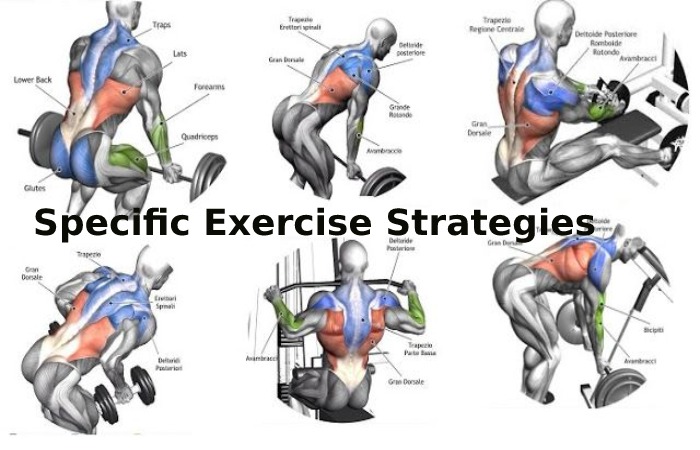Table of Contents
What are Back Exercises?
Back Exercises help to reduce stiffness by keeping the connective fibers of ligaments and tendons flexible. Improved mobility through back exercise helps prevent the connective fibers from tearing under stress, preventing injury and back pain.
Exercise and Fitness to Help Your Back
A common (and damaging) misconception is that exercise should be side-stepped when a patient is experiencing back pain. Logically, many patients are reluctant to exercise out of fear that any activities or stretching will worsen their surviving back pain. This may make them rely too heavily on medical conduct and underemphasize the importance of exercise for healing and long-term back pain relief.
With most back problems, exercise and movement are the natural stimuli for the healing process. Controlled, gradual, progressive exercise, rather than inactivity and bed rest, often offers the best long-term solution to reducing back pain and preventing (or lessening) future episodes.
Most experts recommend no more than a day or two of rest at the onset of most episodes of back pain. Prolonged inactivity can cause pain as the back becomes stiff, weak, and deconditioned. As pain increases, many patients reduce their activity and exercise levels, causing more back pain and exacerbating the cycle of inactivity and back pain recurrence.
Exercise plays a dual role in back pain and helps prevent future episodes of pain.
More Exercise Info:
- Sciatica Exercises
- Stretching and Back Pain
- Back Strengthening Exercises
By nourishing and repairing spinal structures, exercise helps alleviate existing back problems. Movement and exercise keep the anatomy of the back healthy and strong to reduce the chances of further injury and back pain.
It is always suitable for patients to first consult with a health professional before beginning any exercise or fitness program. Working with a physician or experienced spine specialist will ensure that patients’ activities are safe for their back for their overall health. With back pain, it’s essential to get an accurate diagnosis for the cause of the patient’s pain from a physician or chiropractor to rule out possible types of back pain that may be aggravated by exercise (such as spinal instability).
How Exercise Helps the Back
Engaging in exercise and fitness events helps keep the back healthy by allowing discs to exchange fluids which is how the disc receives its nutrition. A fit disc will swell with water and squeeze it out, similar to the action of a sponge, and this sponge action distributes nutrients to the disc.
In addition, fluid exchange helps reduce the swelling in the other soft tissues surrounding injured discs. When exercise is absent, swelling increases and discs become malnourished and degenerated.
Another substantial effect of exercise is that it stretches, strengthens, and repairs muscles that help to care for the back. The back and abdominal muscles’ performance as an internal corset supports the vertebrae discs, facet joints, and ligaments. When the back and abdominal muscles are weak, they cannot support the back properly. Back strengthening exercises help to improve these supporting muscles to prevent straining soft tissues (e.g., muscles, ligaments, and tendons) and provide sufficient support for the structures in the spine.
Integrating Exercise with Medical Treatment
Exercise and fitness are essential for healing existing back problems, recovering from back surgery, and especially keeping the back healthy to benefit prevent (or at least lessen) upcoming periods of back pain.
An exercise and fitness program should be combined during most phases of treatment for pain relief and to improve patients’ overall health. If the pain is severe, patients may first need to be treated for the pain before starting a back exercise program.
Specific Exercise Strategies

The following guidelines and insights help patients plan and follow through with a safe and effective exercise program to condition the back. The critical goals of engaging in exercise and fitness activities are to aid the healing process for an injured back and alleviate existing back pain while helping to prevent (or at least minimize) future problems.
Find the Right Professional
Patients should continuously consult a physician before beginning any exercise or fitness program. A health professional can help create an appropriate list of back exercises and activities to participate in or avoid. Health care professionals such as physical therapists, chiropractors, and physicians specializing in physical medicine and rehabilitation (physiatrists) often have specialized training and experience in exercise and fitness programs for pain relief. It’s essential to see a doctor who has experience with spinal disorders and back pain, as different back conditions often require various exercise programs.
Expect Some Initial Discomfort
However, start gently because the results of back training, such as B. pain, may not be felt until 24 to 48 hours after the training conference. Beginning an exercise program later, an episode of back pain is likely to cause increased pain at first. However, back pain that occurs during exercise should be “good pain.” This pain is expected as a natural part of increased activity and stretching of tissues that have become stiff and deconditioned.
Set a Careful Pace When you Start Exercising
When returning to action after an episode of pain or surgery, unwind with back exercises and physical activity. Be careful not to strain or strain muscles that may become weak after a period of inactivity. Given that initial discomfort can occur, a cautious approach to back exercises can help keep back pain under control and prevent a flare-up.
Add a Combination of Stretching, Strengthening, and Low-Impact Aerobic Conditioning Exercises
Utilizing these three training components will help heal existing problems, prevent injury, and prevent future problems. The muscles become more robust and flexible, repairing the tight muscles that cause back pain. Low-impact aerobic conditioning helps stretch and strengthen your back and your abs and hamstrings, two powers that support your back.
Participate in Gentle Forms of Exercise, Such as Water Therapy or Walking.
Exercising in the water may be more comfortable for patients with severe back pain than on land. Water therapy provides the therapeutic benefits of pain relief and can also help prepare the body for more intense exercise. Another form of low-impact physical activity is walking, a good option for patients with less pain who want to move on to more intense exercise on land.
Information about the Training Program:
- Pilates for back pain
- Yoga for back problems
- Tai Chi for back pain
Consider Alternative Forms of Exercise Pilates, Yoga, or Tai Chi.
Pilates, yoga and tai chi offer gentle strengthening and stretching exercises that can help relieve existing back pain. They help improve overall fitness and position, which in turn helps prevent future bouts of back pain. Other benefits of alternative therapies such as Pilates, yoga, and tai chi include stress reduction and relaxation, which can also help relieve back pain.
Know when to Re-evaluate Your Training and Fitness Program.
If back pain becomes severe during exercise, it is important to redesign your back exercise program with the help of an expert. The individual patient is the best critic of whether the pain experienced during exercise is normal or whether the pain intensity indicates that the patient should discontinue the specific training.
Build a Motivational Support System Throughout the Exercise Program.
Friends and family can often encourage patients to rest and avoid physical activity, as there is a misconception that exercise causes back pain. However, the opposite occurs when patients perform the proper back exercises. The patient may need to educate others on the importance of back exercises and physical fitness to relieve back pain. Talking to friends and family about plans to start exercising and asking for their support can help make the program a success.
Keep Written Records of the Progress Made During the Training and Fitness Program.
Tracking progress is helpful to both the patient and the healthcare professionals helping with the exercise program. Records could include a list of specific back exercises performed, the number of sets and repetitions, exercise duration, and pain and sensations experienced during training. This helps the patient and exercise professional track progress towards fitness goals and ensures that information is accurately communicated between professionals and the patient. Monitoring progress can also help keep the patient motivated to continue the exercise and fitness program.
19 Great Exercises for a Stronger Back
If you’re a beginner, choose 3–5 exercises below and do 1 set each twice a week. Slowly, work your way up to 3 sets each over a few weeks.
If you know strength training, choose 3–5 exercises and do three sets each twice a week (or more). Aim to hit all 15 exercises within two weeks to ensure your routine is well-rounded.
- Resistance band pull-apart. Why it’s on the list: A great exercise to boost off your back workout, the resistance band pull-apart is simple but effective.
- Lat pulldown.
- Back extension.
- Suspended row.
- Wood chop.
- Good morning.
- Quadruped single-arm dumbbell row.
- Wide dumbbell bent-over row.
- Barbell deadlift.
- Superman.
- Single-arm dumbbell row.
- Renegade dumbbell row.
- Reverse fly.
- Pullups.
- Forearm plank.
- Smith machine row.
- Seated row.
- Chest-supported row
- Dumbbell Pullover
Directions:
- Choose two light dumbbells (it’s best to start with lighter weights to ensure proper form and maximize the range of motion).
- It would help if you lay on your back on an exercise bench, feet flat on the floor, and a dumbbell in each hand on your chest.
- Engage your core and stretch your arms toward the ceiling in front of your chest. Hold the dumbbells close together, elbows slightly bent, and palms in. This is the starting position.
- Slowly extend your arms behind you to bring the dumbbells back and over your head. Avoid going past their ears and keep them visible from the corner of your eyes. Make sure your ribs stay in contact with the bench.
- T breaks, slowly bringing the dumbbells back to the initial position.
- You should do 1 to 4 sets of 8 to 12 reps.
9 Moves for the Best Back Workout Ever
Strengthening your back has aesthetic benefits, but more importantly, it’s essential for better daily functioning, including posture and injury prevention. (Because who likes back pain, right?)
If you’re determined to build a more muscular back but unsure what to do or where to start, you’ve come to the right place. Here are six exercises and three stretches to ensure you’re giving your back muscles some TLC.
- High rotating plank.
- Dumbbell pullover.
- High pulley cable row.
- Bent-over row.
- Rear delt fly.
- Child’s Pose.
- Twist
- Cat-Cow
- Superman.
Conclusion
Strengthening your back has many benefits, the most important being that it can help protect you from many forms of back pain. These exercises will provide everything you need to function better and feel stronger.
Remember, as you progress in these exercises, continue to challenge yourself by adding weight or resistance. Do so cautiously and stop if you ever experience pain during a movement. If you have a history of back problems, consult your doctor or a physical therapist before proceeding.

